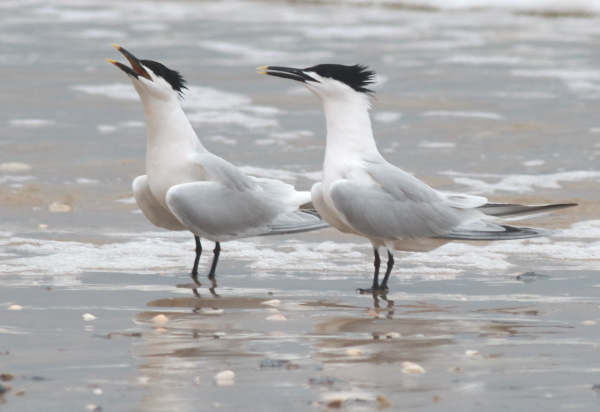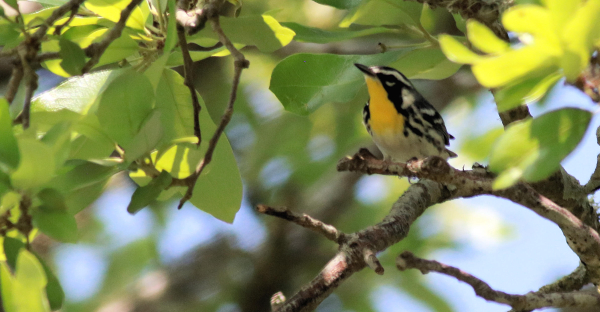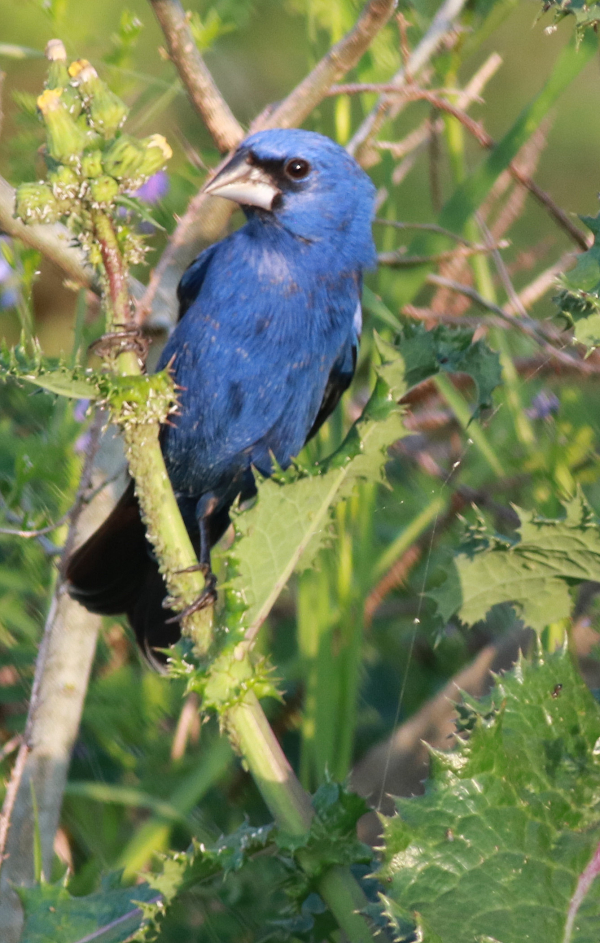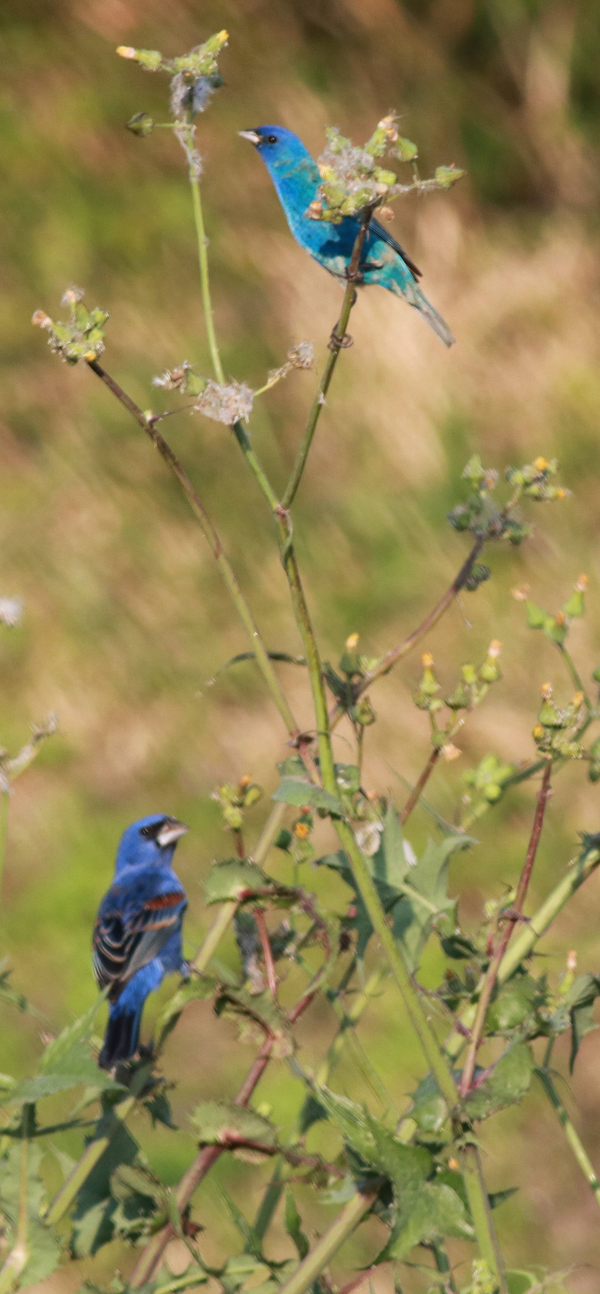
A pair of Sandwich Terns displays along the Bolivar Peninsula near High Island.

A documentary photo of a Yellow-throated Warbler taken from the High Island Skywalk is Paul’s first photo of this species, which he last viewed many springs ago in New Jersey.

A Blue Grosbeak provided the best songbird photo of the trip as the photographer tried to fend off a surprise swarm of monsta mosquitos.

Two blue birds in the same photo frame – newly arrived from the tropics, an Indigo Bunting and a Blue Grosbeak feed at thistle plants.
|
What a week for exploring the top of the Gulf Coast from northern Florida across the panhandles of Florida, Alabama, and Mississippi, then on through Louisiana to southeast Texas! I took my time, drove many back roads along and near the coast, stopped at birding hotspots I have long been interested in visiting, and happened across a great new site that I’ve never heard of before by pure luck. Along the way I found the first warblers of the trip, plenty of exciting water-oriented birds, a variety of new migrants, and one new species I have long been interested in seeing in a tall pine forest.
Instead of overwhelming you with the variety and numbers of birds I saw along the way and at hotspot stops, which would not be very rewarding for you all, please permit me to provide an account of a special species or 2 that left an impression on me at key locations. Here goes:
After bidding so-long to the last pair of Swallow-tailed Kites I would see for some time in northern Florida. South of the capitol, I visited 2 birding hotspots that have been high on my list: St. Mark’s National Wildlife Refuge and Wakulla Springs State Park, and both provided memorable birds and surroundings – the most exciting of which was a pair of Prothonotary Warblers that were interacting on some fallen logs on the edge of a little stream that wound its way through the southern forest to coastal wetlands.
South of Mobile, Alabama, I drove to the end of the road last Thursday morning; to Dauphin Island, a long barrier isle famous for spring stopovers by migrating songbirds. And what better location to visit than the Dauphin Island Audubon Bird Sanctuary, a beautiful gem of land with woodlands, undergrowth, different wetland types, and the beach; all in a small package with lots of hiking trails. It was easy to imagine a spring morning when the green humid woods will be filled with songbirds fresh from the tropics; partly ‘cuz that will happen time and time again in the next couple weeks. But that morning I savored seeing 3 Brown Thrashers and a like number of active Red-bellied Woodpeckers among the other species on hand.
Next stop was Big Branch Bayou, also known as Big Branch Marsh National Wildlife Refuge. It wasn’t on my radar, but the late afternoon light beckoned me to find birds to photograph, as did my inner spirit. West of the Mississippi state border and Slidell, Louisiana, a brown government road sign dictated my turn off the highway and south to the refuge. I chronicle my unplanned stop at this little-known refuge in this issue’s Birding Lifestyles article, but share here that the refuge lands are impressive and extensive. The highlight was adding a new life bird to the “list” of birds I have seen to date – a rare event these days within the United States and Canada. I was thrilled to spend time in the company of a “clan” of Red-cockaded Woodpeckers among tall pines on the edge of the Marsh, and to get a few documentary photos of these rare birds.
Friday morning I drove south of Lafayette, Louisiana, to cruise along the southern-most coastal roadway west toward the Texas border. My route passed through extensive shallow coastal wetlands, and at times skirted the Gulf Coast itself. I had long been interested in visiting Sabine National Wildlife Refuge, and my route also skirted the northern edge of Rockefeller National Wildlife Refuge and the associated Rockefeller Wildlife Area. Along the way, birds were plentiful, but the standouts were my first sightings of Sandwich Terns during this trip, and a surprise pair of Swainson’s Hawks, which seemed to be quite a distance east of where I would expect to see them, even as they migrate northward.
Later that day, I reached High Island again, adjacent to the Gulf Coast in southeast Texas. I was compelled to return to this remarkable location to photograph big pink birds (Roseate Spoonbills) and other nesting wading birds at the remarkable High Island Rookery. My plan was to spend the weekend through Tuesday, producing this issue of The Birding Wire and taking photo breaks during the second half of sunny afternoons when the light was best at the rookery. You can see more about that action in this issue’s Bird Photography feature article. At the same time, I was hoping to catch a little songbird action as the first neotropical migrants were starting to appear along our southern coast.
The First Warblers
As noted earlier, a pair of Prothonotary Warblers were the first warblers I sighted this spring, and for a while, I was seeing a new warbler each day. At Big Branch Bayou a Black-and-White Warbler was a welcome sight. At Sabine Refuge, Common Yellowthroats were an exciting find among the emergent plants. Saturday proved to be a big warbler day – or at least it was for about 10 minutes. As I walked along the new Canopy Walkway toward the Smith Oaks Rookery, I noticed small motions midway up a beautiful tree, but only a few feet above my eye level on the elevated skyway.
I tuned in on one of the birds that remained in the shadows of the afternoon, behind this leaf and that branch, until it finally revealed its Northern Parula identity – beautiful bird. As it faded into the background, I turned to another motion among the leaves that eventually turned out to be a Yellow-throated Warbler, which I was able to photograph on a documentary level. However, this was the first photo of the species I have ever taken, and it’s the first Yellow-throated Warbler I’ve seen since the ‘90s when birding in New Jersey – and what a fine bird it is! A third warbler revealed itself too, another Black-and-White Warbler, a species I had a breakout day with during last spring’s warbler migration in Dakota. And with the snap of a finger, like magic, all warblers were gone, just like that.
As the crowning touch on the first week of songbird migration (for me), after being thrilled photographing the wading birds at the rookery again Monday afternoon, while driving along the edge of High Island a couple hundred feet past the rookery road when I suddenly noticed 2 birds at ground level at the roadside. My first thought was bluebirds? Blue birds indeed – Blue Grosbeaks! They were feeding on thistle seeds still on the thistle plants, and I parked and walked back with my camera and lots of hope. I managed a couple photos before a car drove by and the blue birds flew 100 feet up the road, only to join 3 other blue birds – 3 Indigo Buntings! Wow! I even managed a photo of both species on the same thistle stalk. As I walked back to my vehicle, a Baltimore Oriole flew low in front of me – what a nice indicator of an apparent songbird migration flight that made a stopover at the famous High Island during my early stopover.
I found another group of male Blue Grosbeaks a quarter-mile up the road, and photographed one beauty while a horrible swam of monsta mosquitoes assaulted me from head to toe. In spite of my almost constant movements trying to thwart the nasty insects’ bloodlust, the Grosbeak did not despair and allowed me to photograph it in the waning light. With clouds and rain predicted for Tuesday, and this issue of The Birding Wire due that afternoon, I thought it was a wonderful way to end my High Island run. But then 3 Swainson’s Hawks swirled in on a blast of wind, fresh from northern Argentina via Panama no doubt; maybe headed for Dakota? That reminded me I saw my first Broad-winged Hawk of spring Saturday over High Island’s famous Boy Scout Woods.
High Island is famous for fallouts and migration stops of migrating neotropical migrants, and this was just a taste of what will transpire in coming days and weeks. Most of the birding lands at High Island are owned and managed by Houston Audubon, and the more I learn about their work, the more impressed I become – I want to be a member of this illustrious group! In the meantime, what will the south wind bring your way this week? The third week in April can be pretty special as spring migration progresses. Enjoy the season and all its birds!
Article and photos by Paul Konrad
Share your bird sightings and photographs at editorstbw2@gmail.com